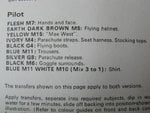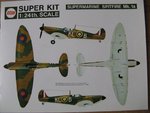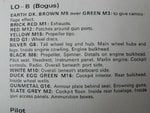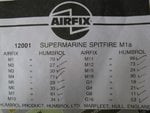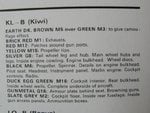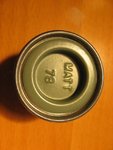Navigation
Install the app
How to install the app on iOS
Follow along with the video below to see how to install our site as a web app on your home screen.
Note: This feature may not be available in some browsers.
More options
You are using an out of date browser. It may not display this or other websites correctly.
You should upgrade or use an alternative browser.
You should upgrade or use an alternative browser.
Spitfire Mk 1 Humbrol colours?
- Thread starter Alte Hase
- Start date
Ad: This forum contains affiliate links to products on Amazon and eBay. More information in Terms and rules
More options
Who Replied?Airframes
Benevolens Magister
Humbrol No.29 Dark Earth, No. 30 Dark Green, and the nearest to 'Sky' is No. 23 Duck Egg Blue.
Recently, the No.30 seems to be a bit bright, an example of the poor quality and inconsistency of Humbrol paints since the demise of the original factory, so I tend to use No.163 (Satin) Dark Green, which has a more authentic tone. Also, depending on which squadron etc, you may wish to add a tiny spot of yellow or green to the Duck Egg Blue - trial and error will give you the desired hue - to achieve the correct colour. Research into the actual aircraft being modelled will indicate the probable colour used. There was some discussion on this subject in the BoB Group Build threads IIRC.
Recently, the No.30 seems to be a bit bright, an example of the poor quality and inconsistency of Humbrol paints since the demise of the original factory, so I tend to use No.163 (Satin) Dark Green, which has a more authentic tone. Also, depending on which squadron etc, you may wish to add a tiny spot of yellow or green to the Duck Egg Blue - trial and error will give you the desired hue - to achieve the correct colour. Research into the actual aircraft being modelled will indicate the probable colour used. There was some discussion on this subject in the BoB Group Build threads IIRC.
I agree with Terry. Aditionally Hu 90 compares best with an MAP matched chip of Sky, but Hu 23 is not far off, although it has a more greyish-blueish tonality to it. Personally I go for Hu 90 to depict RAF aircraft for the period June - December 1940. After that there is not much doubt that Hu 90 is appropriate. If you are going to achieve a washed out/faded effect for Sky, then Hu 23 might be a starting point.
Airframes
Benevolens Magister
Ah, yes! Thank you my friend, I had forgotten about Humbrol 90, probably due to it being called Beige Green ! No wonder I can never find it when I go to the LHS!
I wonder why they discontinued 'Sky' - in fact, why did they discontinue the 'Authenticolour' range??!!
I wonder why they discontinued 'Sky' - in fact, why did they discontinue the 'Authenticolour' range??!!
I wonder why they discontinued 'Sky' - in fact, why did they discontinue the 'Authenticolour' range??!!
I don't think they take care of us modellers. The most important and only goal for them is to have "a full own pocket". For the purpose they gave up the enamel series because if a modeller doesn't have any choice he buys what there is.
- Thread starter
- #6
Thanks for all your input guys. Additionally, would Hu90 be the most accurate match for a Mk 1 interior? It seems very close to photos I've seen.
Looking at the photos of the Mk 1 that is on display at Hendon (an original BoB machine) it seems like the underside was a bit less 'green' and more greyish than Hu90 on the underside, but the light in the photos is very low... I'm confused!
So as far as exterior goes, would Hu 29, Hu 30 and Hu 90 be the most accurate paints to use for depicting the average Mk 1 from June-September 1940?
Looking at the photos of the Mk 1 that is on display at Hendon (an original BoB machine) it seems like the underside was a bit less 'green' and more greyish than Hu90 on the underside, but the light in the photos is very low... I'm confused!
So as far as exterior goes, would Hu 29, Hu 30 and Hu 90 be the most accurate paints to use for depicting the average Mk 1 from June-September 1940?
Last edited:
Hotntot
Senior Airman
I'd say Hu90 for the interior is your best match. Then Hu29, Hu30 for your top sides and probably Hu23 for the underside as the Hu90 is quite green in comparison. As you can see from these instructions Hu90 (or Airfix M16) is depicted as the underside colour but it will already be the interior colour. And as Wurger says, you can achieve a more washed out/faded effect with Hu23 which you might like. Here's a list of Humbrol paints that was included in an Airfix Spit MkI kit that I got not too long ago plus a pic of the colour scheme and some camo colour instructions to boot. Hope it helps.
Attachments
Humm... Hu90 as the cockpit interior seems to be a little bit incorrect one because it is more greenish than greyish. It's suggested that these very early Spitfires might have had cockpits painted with colours that were more greenish than the RAF Interior Green or cockpit green ( FS 34226 ). Also , it is suggested that these colours were the Eau-de-nil and possibly a brighter shade of Apple Green ( close to FS34138 or Humbrol 131 Satin Mid Green ) that seems to be slightly brighter and deeper than Duck Egg Green. But I don't think it is the one that should be used for all new Spitfires introduced in 1939 and later. The Morgan/Shacklady book provides some Air Ministry orders from 1937. All Aluminium parts were to be protected by ADM 324, followed by a coat of yellow chromate to DTD 260 followed by a finishing coat pigmented with aluminium to DTD 260. Cokpit interior to be finished in grey/green cellulose enamel to DTD 63. However it is possible these orders weren't followed initially.
Here a few numbers for the RAF Interior Green ....
Humbrol - 78
Gunze Sangyo - 70
Xtracolor - X10
Lifecolor - UA060
Pactra - A117
Polly Scale - British Interior Gray Green - Floquil Product Number: F505270
Vallejo 85
Here a few numbers for the RAF Interior Green ....
Humbrol - 78
Gunze Sangyo - 70
Xtracolor - X10
Lifecolor - UA060
Pactra - A117
Polly Scale - British Interior Gray Green - Floquil Product Number: F505270
Vallejo 85
Last edited:
- Thread starter
- #9
Thank you all very much for the help!
I really appreciate it! Interestingly, the Airfix instructions call for H70 brick red for the exhausts, and the Tamiya instructions say they must be Tamiya XF-56 metallic gray. I was thinking maybe Tamiya X-33 bronze would work? Any suggestions here perhaps guys?
I really appreciate it! Interestingly, the Airfix instructions call for H70 brick red for the exhausts, and the Tamiya instructions say they must be Tamiya XF-56 metallic gray. I was thinking maybe Tamiya X-33 bronze would work? Any suggestions here perhaps guys?
These exhaust pipes were made of steel. The kind of matal gets a rusty colour often. A burnt steel oxidizes easier because of the weather conditions e.g. rain. In other words because of water. So the rust colour Hu 113 seems to be better. But the Hu70 Brick can be used as well. I would suggest using one of these mantioned here. Then use a thinned black colour for a wash and brush these exhausts overall. Do the same using a silver paint for a way called "dry brush". Finally use a light grey or just a white colour brushing at the pipe endings to imitate exhaust stains. This should make them looking very nice.
Spitfire exhausts were made of an alloy whose name evades me at the moment,but please,please,not brick red or rust coloured.I've lost count of how many models I've seen painted like that!
They were actually far more variable and interesting than that.
Here's just a few examples.




And one modern one.

Cheers
Steve
They were actually far more variable and interesting than that.
Here's just a few examples.
And one modern one.
Cheers
Steve
Airframes
Benevolens Magister
Yep, they varied from almost a black coloured metal, through browns and 'steel' colour, to virtually bright orange! That last pic looks like one of my BBMF shots, taken at Coningsby in the 1982 - '83 season (probably the MkV, AB910) - note the differing heat-induced tones along even the length of each separate pipe.
Aaron Brooks Wolters
Brigadier General
The fourth one from the front looks like it might have been just a bit on the lean side on mixture in that last shot.
Hotntot
Senior Airman
Humm... Hu90 as the cockpit interior seems to be a little bit incorrect one because...
Fab detail there Wurger. I've certainly noted all that for another day...
prem895
Staff Sergeant
Would Revell 68 work for interior?
Humm... Hu90 as the cockpit interior seems to be a little bit incorrect one because it is more greenish than greyish. It's suggested that these very early Spitfires might have had cockpits painted with colours that were more greenish than the RAF Interior Green or cockpit green ( FS 34226 ). Also , it is suggested that these colours were the Eau-de-nil and possibly a brighter shade of Apple Green ( close to FS34138 or Humbrol 131 Satin Mid Green ) that seems to be slightly brighter and deeper than Duck Egg Green. But I don't think it is the one that should be used for all new Spitfires introduced in 1939 and later. The Morgan/Shacklady book provides some Air Ministry orders from 1937. All Aluminium parts were to be protected by ADM 324, followed by a coat of yellow chromate to DTD 260 followed by a finishing coat pigmented with aluminium to DTD 260. Cokpit interior to be finished in grey/green cellulose enamel to DTD 63. However it is possible these orders weren't followed initially.
Here a few numbers for the RAF Interior Green ....
Humbrol - 78
Gunze Sangyo - 70
Xtracolor - X10
Lifecolor - UA060
Pactra - A117
Polly Scale - British Interior Gray Green - Floquil Product Number: F505270
Vallejo 85
Would Revell 68 work for interior?
In my opinion too dark and too green.
Steve
prem895
Staff Sergeant
Stona,what do you suggest?
prem895
Staff Sergeant
Crimea_River
Marshal
Doers Humbrol still make this colour (#36)? I bought this many years ago and still think it's a dead ringer for RAF Interior Green:

Users who are viewing this thread
Total: 1 (members: 0, guests: 1)
Similar threads
- Replies
- 5
- Views
- 1K

